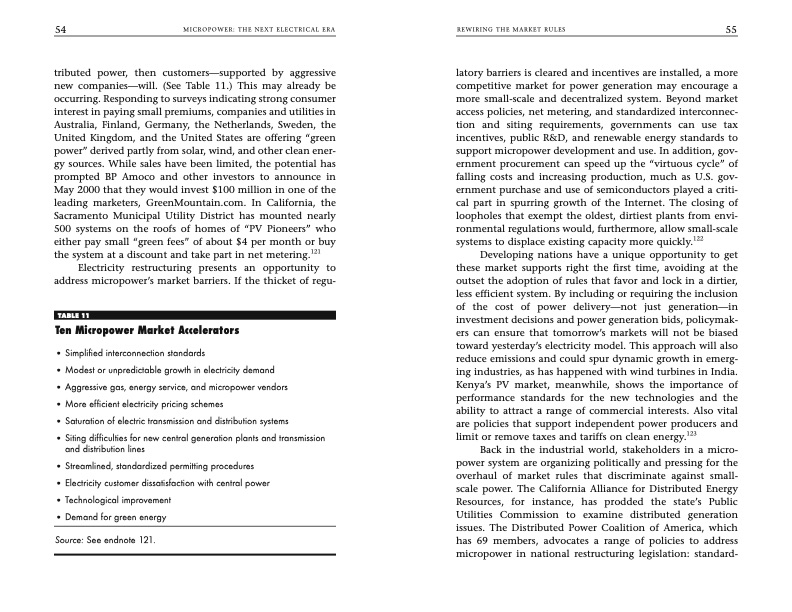
PDF Publication Title:
Text from PDF Page: 028
54 MICROPOWER: THE NEXT ELECTRICAL ERA REWIRING THE MARKET RULES 55 tributed power, then customers—supported by aggressive new companies—will. (See Table 11.) This may already be occurring. Responding to surveys indicating strong consumer interest in paying small premiums, companies and utilities in Australia, Finland, Germany, the Netherlands, Sweden, the United Kingdom, and the United States are offering “green power” derived partly from solar, wind, and other clean ener- gy sources. While sales have been limited, the potential has prompted BP Amoco and other investors to announce in May 2000 that they would invest $100 million in one of the leading marketers, GreenMountain.com. In California, the Sacramento Municipal Utility District has mounted nearly 500 systems on the roofs of homes of “PV Pioneers” who either pay small “green fees” of about $4 per month or buy the system at a discount and take part in net metering.121 Electricity restructuring presents an opportunity to address micropower’s market barriers. If the thicket of regu- TABLE 11 Ten Micropower Market Accelerators • Simplified interconnection standards • Modest or unpredictable growth in electricity demand • Aggressive gas, energy service, and micropower vendors • More efficient electricity pricing schemes • Saturation of electric transmission and distribution systems • Siting difficulties for new central generation plants and transmission and distribution lines • Streamlined, standardized permitting procedures • Electricity customer dissatisfaction with central power • Technological improvement • Demand for green energy Source: See endnote 121. latory barriers is cleared and incentives are installed, a more competitive market for power generation may encourage a more small-scale and decentralized system. Beyond market access policies, net metering, and standardized interconnec- tion and siting requirements, governments can use tax incentives, public R&D, and renewable energy standards to support micropower development and use. In addition, gov- ernment procurement can speed up the “virtuous cycle” of falling costs and increasing production, much as U.S. gov- ernment purchase and use of semiconductors played a criti- cal part in spurring growth of the Internet. The closing of loopholes that exempt the oldest, dirtiest plants from envi- ronmental regulations would, furthermore, allow small-scale systems to displace existing capacity more quickly.122 Developing nations have a unique opportunity to get these market supports right the first time, avoiding at the outset the adoption of rules that favor and lock in a dirtier, less efficient system. By including or requiring the inclusion of the cost of power delivery—not just generation—in investment decisions and power generation bids, policymak- ers can ensure that tomorrow’s markets will not be biased toward yesterday’s electricity model. This approach will also reduce emissions and could spur dynamic growth in emerg- ing industries, as has happened with wind turbines in India. Kenya’s PV market, meanwhile, shows the importance of performance standards for the new technologies and the ability to attract a range of commercial interests. Also vital are policies that support independent power producers and limit or remove taxes and tariffs on clean energy.123 Back in the industrial world, stakeholders in a micro- power system are organizing politically and pressing for the overhaul of market rules that discriminate against small- scale power. The California Alliance for Distributed Energy Resources, for instance, has prodded the state’s Public Utilities Commission to examine distributed generation issues. The Distributed Power Coalition of America, which has 69 members, advocates a range of policies to address micropower in national restructuring legislation: standard-PDF Image | Micropower: The Next Electrical Era

PDF Search Title:
Micropower: The Next Electrical EraOriginal File Name Searched:
EWP151.pdfDIY PDF Search: Google It | Yahoo | Bing
Capstone Turbine and Microturbine: Capstone microturbines used and new surplus for sale listing More Info
Consulting and Strategy Services: Need help with Capstone Turbine, sizing systems, applications, or renewable energy strategy, we are here to assist More Info
Container Lumber Dry Kiln: Since 1991 developing and innovating dry kilns using standard shipping containers More Info
Supercritical CO2 Lumber Dry Kiln: Compact fast drying in 3 days or less for small amounts of wood and lumber drying More Info
BitCoin Mining: Bitcoin Mining and Cryptocurrency... More Info
Publications: Capstone Turbine publications for microturbine and distributed energy More Info
FileMaker Software for Renewable Energy Developing database software for the renewable energy industry More Info
CO2 Gas to Liquids On-Demand Production Cart Developing a supercritical CO2 to alcohol on-demand production system (via Nafion reverse fuel cell) More Info
Stranded Gas for low cost power Bitcoin Mining Using stranded gas for generators may provide breakthrough low power costs for cryptocurrency miners. More Info
| CONTACT TEL: 608-238-6001 Email: greg@globalmicroturbine.com | RSS | AMP |